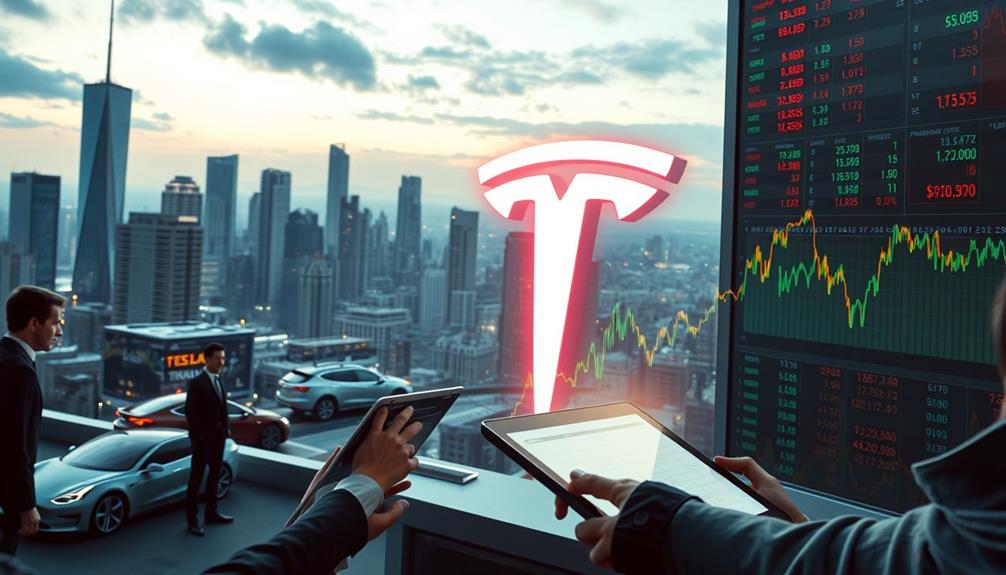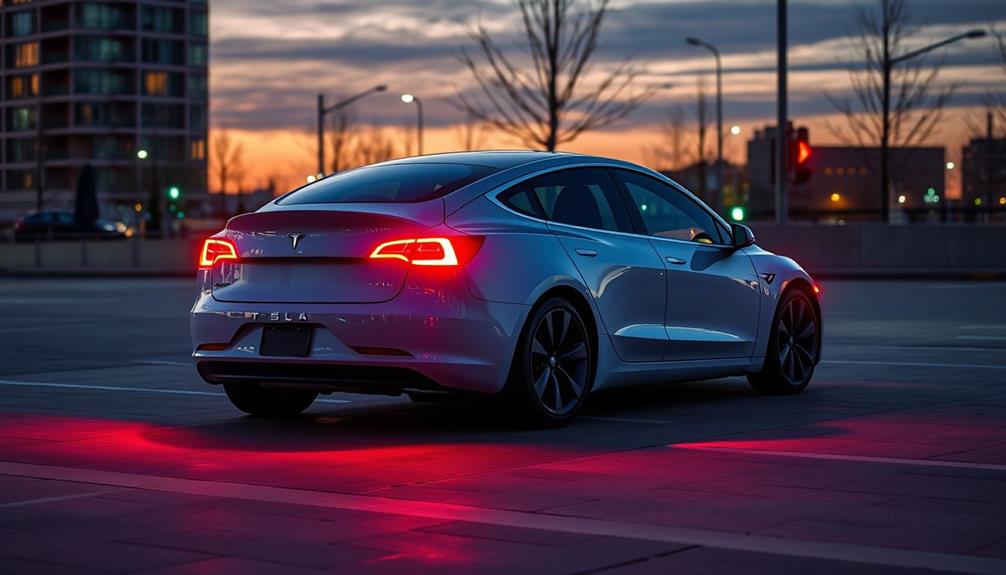The Tesla tax credit can save you up to $7,500 on your federal taxes when buying a new electric vehicle, provided it meets certain criteria. Your Tesla must be assembled in North America and fall under specific price caps—$55,000 for cars and $80,000 for SUVs. Income limits also apply, such as $150,000 for single filers. If you're considering a used Tesla, you could receive up to $4,000 in credits. Knowing the ins and outs can maximize your savings, so stick around to uncover details about eligibility and additional incentives available to you.
Key Takeaways
- The federal tax credit for new electric vehicles can provide up to $7,500 off your taxes if the vehicle qualifies under current regulations.
- Eligibility requires the vehicle to be assembled in North America and meet specific price caps: $55,000 for cars and $80,000 for SUVs/trucks.
- Income limits are set at $150,000 for single filers, $225,000 for heads of household, and $300,000 for married couples filing jointly.
- For used EVs, you can claim up to $4,000 or 30% of the purchase price, provided the vehicle is at least two years old.
- Form 8936 is needed to claim the tax credit, and starting in 2024, credits may be transferable at the point of sale for instant discounts.
Overview of Tesla Tax Credit
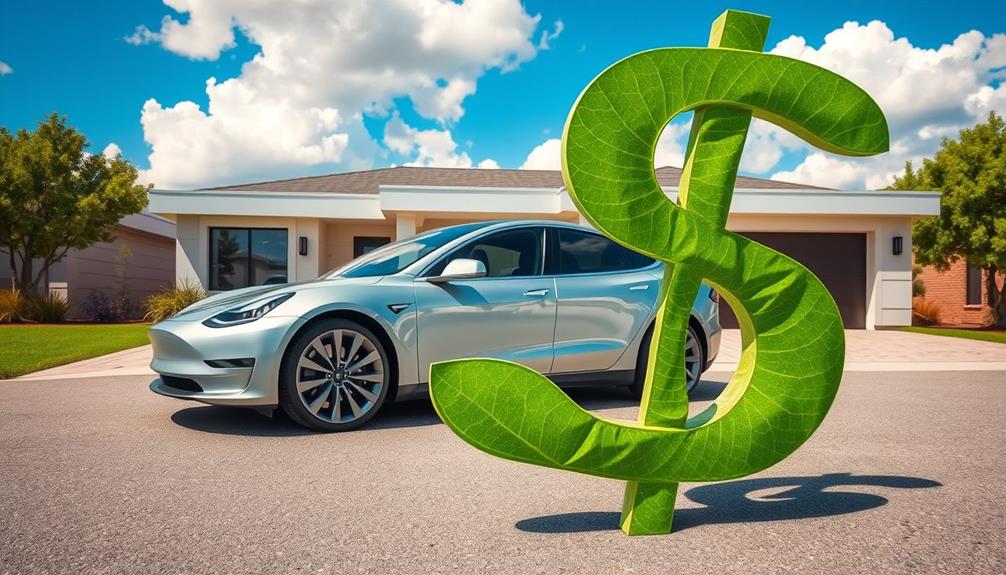
The Tesla tax credit offers eligible buyers up to $7,500 off their federal taxes when purchasing a qualifying new electric vehicle (EV) under the Inflation Reduction Act, starting in 2024.
This federal tax incentive is an excellent opportunity for you to save money while going green. To qualify, your chosen vehicle must be assembled in North America and meet specific price caps—$55,000 for passenger cars and $80,000 for SUVs and trucks.
When considering models, the popular Model Y and Model S may qualify for the full $7,500 credit, while the Model 3's eligibility can vary based on its specifications.
Additionally, you need to be aware of the income limits set for eligibility: $150,000 for single filers, $225,000 for heads of households, and $300,000 for married couples filing jointly.
On top of the Tesla tax credit, you might also find state-specific incentives and rebates that can further boost your overall savings.
Eligibility Criteria for 2024
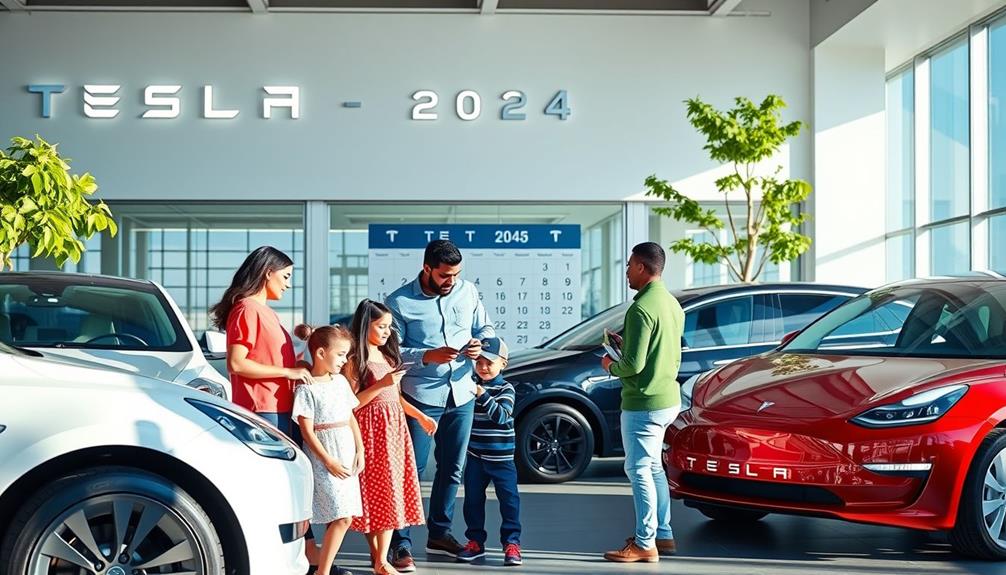
To qualify for the 2024 Tesla tax credit, you need to meet specific income limits and vehicle price caps.
Your Tesla must also be assembled in North America to be eligible.
Understanding these criteria is key to maximizing your savings on a new electric vehicle.
Income Limits Overview
In 2024, income limits play a significant role in determining your eligibility for the federal EV tax credit. Understanding these limits is important to guarantee you qualify for this tax benefit. The Modified Adjusted Gross Income (MAGI) will be the benchmark for evaluating your eligibility. If your income exceeds the established limits, you might need to repay the credit when filing your taxes.
Here's a quick overview of the income limits for different filers:
| Filer Type | Income Limit | Used EV Income Limit |
|---|---|---|
| Single Filers | $150,000 | $75,000 |
| Head of Household | $225,000 | $112,500 |
| Married Filing Jointly | $300,000 | $150,000 |
It's imperative to check your income eligibility annually, as any changes in your adjusted income can affect your ability to claim the tax credit. By staying informed about these limits, you can better navigate your finances and maximize your savings when purchasing an electric vehicle.
Vehicle Price Caps
For 2024, qualifying for the federal EV tax credit hinges on meeting specific vehicle price caps tailored to your car's classification. The price caps are designed to guarantee that electric vehicles remain affordable for consumers while promoting adoption.
For most electric cars, including Tesla models, the cap is set at $55,000. However, if you're considering an SUV, truck, or van, you have a higher limit of $80,000.
Here are the key points to remember:
- Your vehicle must have final assembly in North America.
- Tesla's Model 3 and Model Y may qualify if they meet the MSRP caps.
- Confirm your modified adjusted gross income (MAGI) doesn't exceed the specified limits.
Under the Inflation Reduction Act, these price caps are vital for determining eligibility for tax credits.
If you want to take advantage of these incentives, make sure your chosen electric vehicle fits within the price cap and meets assembly criteria.
Assembly Requirements Explained
Understanding the assembly requirements is essential if you want to qualify for the 2024 EV tax credit. To be eligible for the tax credit, your vehicle must have its final assembly completed in North America. You can verify this through VIN databases. Additionally, vehicles need to meet the MSRP cap, which is set at $55,000 for sedans and passenger cars, and $80,000 for vans, SUVs, and pickups.
Here's a quick breakdown of the key assembly requirements:
| Requirement | Criteria | Notes |
|---|---|---|
| Final Assembly | Must be in North America | Verified through VIN databases |
| MSRP Cap | $55,000 (cars), $80,000 (vans/SUVs) | Affects eligibility for the tax |
| Minimum Battery Capacity | 7 kilowatt-hours | Required to qualify for the credit |
| Income Limits | $150k (single), $225k (head of household), $300k (married) | Limits eligibility for the tax |
Also, starting in 2024, sourcing battery materials from North America will be essential to qualify for the full credit amount. Make sure your vehicle meets these criteria to take advantage of the EV tax credit!
New Electric Vehicle Qualifications
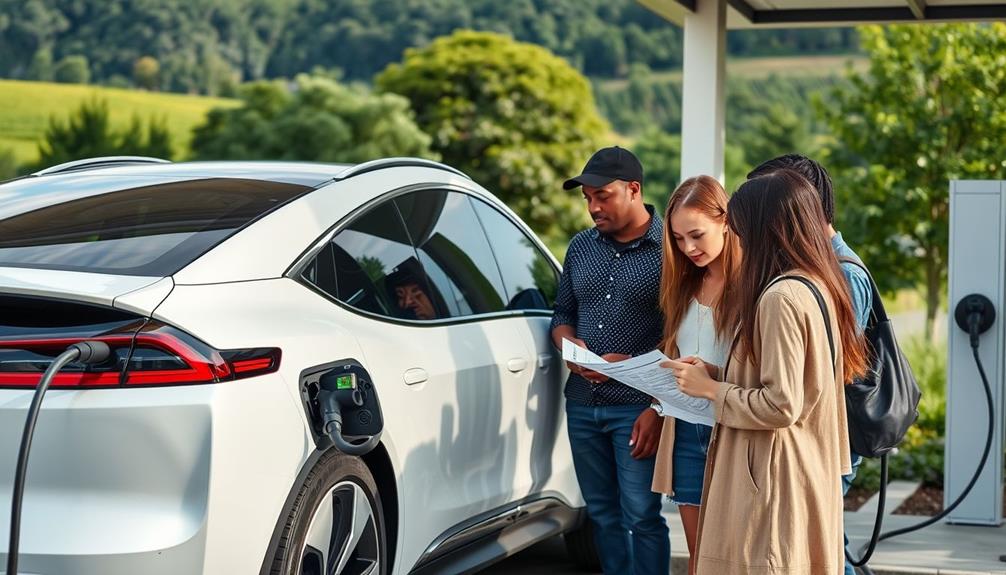
If you're considering a new electric vehicle for the tax credit, you'll need to keep a few key qualifications in mind.
The vehicle's price must stay within specific limits, and it also needs to be assembled in North America.
Additionally, there are income caps and battery capacity requirements that you'll want to check before making a purchase.
Eligibility Criteria Overview
Maneuvering the eligibility criteria for the federal EV tax credit can feel intimidating, but knowing the key requirements can simplify the process. To qualify for this benefit, you'll need to guarantee your electric vehicle meets specific standards set by the Internal Revenue Service.
Here are the primary eligibility criteria:
- The vehicle must have a manufacturer's suggested retail price (MSRP) cap of $55,000 for cars and $80,000 for vans, SUVs, and trucks.
- Income eligibility is capped at $150,000 for single filers, $225,000 for heads of household, and $300,000 for married couples filing jointly.
- The vehicle must be assembled in North America and have a minimum battery capacity of 7 kilowatt-hours.
If your vehicle meets these requirements, you could receive a credit amount of up to $7,500 for qualifying new vehicles purchased.
Vehicle Price Limits
When shopping for a new electric vehicle, it is crucial to keep the price limits in mind to guarantee you qualify for the federal tax credit. Under the Inflation Reduction Act, the Manufacturer's Suggested Retail Price (MSRP) must not exceed $55,000 for sedans and passenger cars, while vans, SUVs, and pickups have an $80,000 cap. These MSRP caps apply to the base price only, excluding destination fees and optional add-ons.
Additionally, to be eligible for a tax credit, the vehicle must have its final assembly in North America, verified through the Vehicle Identification Number (VIN). Some Tesla models, like the Model Y, can qualify for the full $7,500 tax credit under these guidelines, as long as they meet the other requirements too.
Here's a quick overview of the vehicle price limits:
| Vehicle Type | MSRP Cap | Eligible for Tax Credit |
|---|---|---|
| Sedans/Passenger Cars | $55,000 | Yes |
| Vans/SUVs/Pickups | $80,000 | Yes |
| Tesla Model Y | $80,000 | Yes |
| Other EVs | Varies | Check MSRP |
| Check Current Limits | Varies | Always Verify |
Used Electric Vehicle Tax Credits

For those considering the purchase of a used electric vehicle (EV), the used EV tax credit offers a valuable incentive. You could save up to $4,000 or 30% of the purchase price, capped at $25,000 for eligible used EVs.
To qualify, keep these requirements in mind:
- The EV must be at least two model years old.
- It should have a minimum battery capacity of 7 kilowatt hours.
- The purchase must be made from an IRS-registered dealership.
Income requirements also play a role. Single filers can have an income of up to $75,000, heads of households up to $112,500, and joint filers up to $150,000.
Remember, you can only claim the credit for the first transfer of a used EV, meaning it can be claimed once per vehicle's lifetime and limited to one credit every three years.
Claiming the Tesla Tax Credit

Claiming the Tesla tax credit can greatly reduce your overall purchase cost, making it an attractive option for prospective buyers. To claim this credit, you'll need to file your federal income tax return using Form 8936.
It's important to provide adequate documentation, including details like the seller's name, your name, the date of sale, sales price, VIN, and proof of battery capacity for electric vehicles.
For qualifying new Tesla models, you can receive a credit of up to $7,500, but keep in mind the income limits: $150,000 for single filers, $225,000 for heads of household, and $300,000 for joint filers.
If you're considering used Teslas, you can claim a credit of up to $4,000, limited to 30% of the vehicle's purchase price, provided the vehicle is at least two years old and priced under $25,000.
Starting in 2024, there's potential to transfer the EV tax credit at the point of sale, allowing for immediate discounts on your purchase price, pending dealer verification of eligibility.
Make sure to gather all necessary documentation to maximize your savings!
Additional Incentives and Rebates

In addition to the federal tax credit, Tesla buyers can tap into various state and local incentives that further enhance the financial benefits of going electric.
These additional incentives can greatly lower your overall costs and help you maximize your savings.
- State programs like California's Clean Air Vehicle program may provide access to carpool lanes and other perks.
- Many states offer rebates for electric vehicle purchases; for example, New Jersey provides up to $2,000, while Massachusetts gives $3,500 for eligible Teslas.
- Local utility companies often have their own incentives, including cash-back programs and rebates for EV charger installations. For instance, Rhode Island offers up to $1,500 for buying or leasing a qualified electric vehicle.
However, it's essential to be aware of restrictions on double-dipping, as some states may limit how you can stack these benefits.
Understanding the specific regulations will help you make the most of both state and federal electric vehicle incentives, ensuring you enjoy every financial incentive available when you choose to go electric.
Leasing and Tax Credit Implications
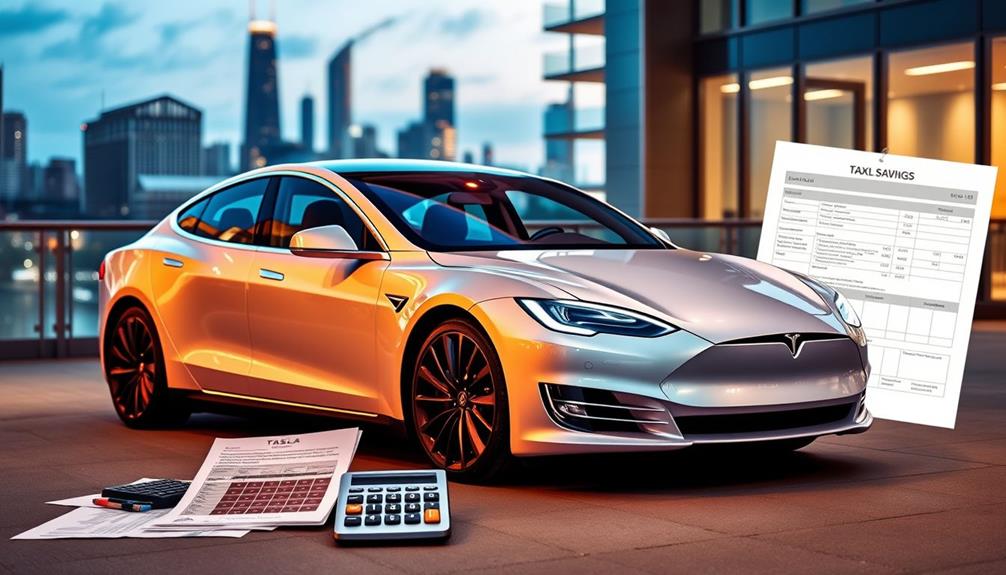
While leasing a Tesla can offer attractive monthly payments, it's important to understand how the federal tax credit impacts this option. When you lease, the EV tax credit of up to $7,500 typically goes to the leasing company, not you. However, this can lead to reduced lease payments, making your monthly costs more manageable.
Leasing companies often apply the tax credit as an instant rebate at the point of sale, allowing you to enjoy those lower payments right away. To pass on these savings, the leasing company must guarantee the vehicle meets all eligibility criteria, including assembly location and battery specifications.
Unlike purchasing a Tesla, you can't claim the EV tax credit directly on your tax returns when leasing. This factor might influence your decision between leasing and buying.
As sourcing requirements become stricter, more consumers are considering leasing, so it's vital to evaluate lease terms, including mileage limits and other conditions.
Ultimately, understanding how the tax credit interacts with leasing can help you make an informed decision that maximizes your savings.
Frequently Asked Questions
How to Take Advantage of a Tesla Tax Credit?
To take advantage of the Tesla tax credit, guarantee your chosen model meets price and assembly requirements. Then, decide between claiming it on your tax return or opting for an instant rebate at the dealership.
How to Claim 500 EV Tax Credit Income Limit?
Think of the income limit as a gatekeeper to savings. To claim the $7,500 EV tax credit, guarantee your income's within $150,000 for singles or $300,000 for couples. Document everything and file accurately.
How Does Tax Credit Save You Money?
A tax credit saves you money by directly reducing your tax liability. When you claim it, you lower the amount you owe or increase your refund, making your overall financial situation more favorable at tax time.
Do You Get Money Back on Taxes for Having a Tesla?
Owning a Tesla's like holding a golden ticket to tax savings. You don't get cash back directly, but you can reduce what you owe up to $7,500, depending on your eligibility and income.
Conclusion
In the world of electric car ownership, the Tesla tax credit acts like a lighthouse guiding you through foggy financial waters. By understanding eligibility and claiming the credit, you can save money while embracing a greener future. Just as a ship navigates towards safe harbor, you’re steering towards savings and sustainability. So, as you commence your electric journey, remember that this tax credit isn’t just a financial tool; it’s a beacon of hope for a cleaner tomorrow. As you continue to maximize the benefits of the Tesla tax credit, consider the additional savings from Tesla’s FSD technology. By integrating this cutting-edge autonomous driving feature, you’ll not only reduce your environmental impact, but also potentially lower your transportation costs. Together, the Tesla tax credit and Tesla’s FSD technology can help steer you towards a more sustainable and economical electric car ownership experience.




